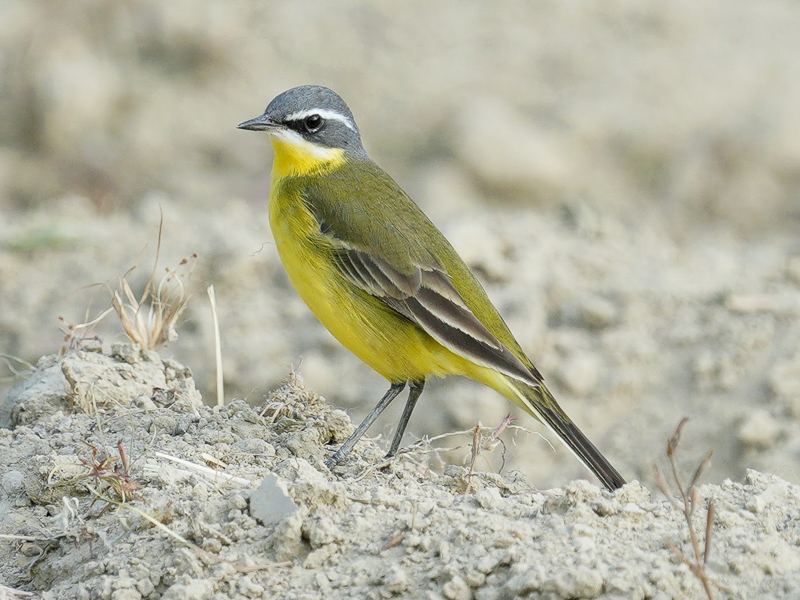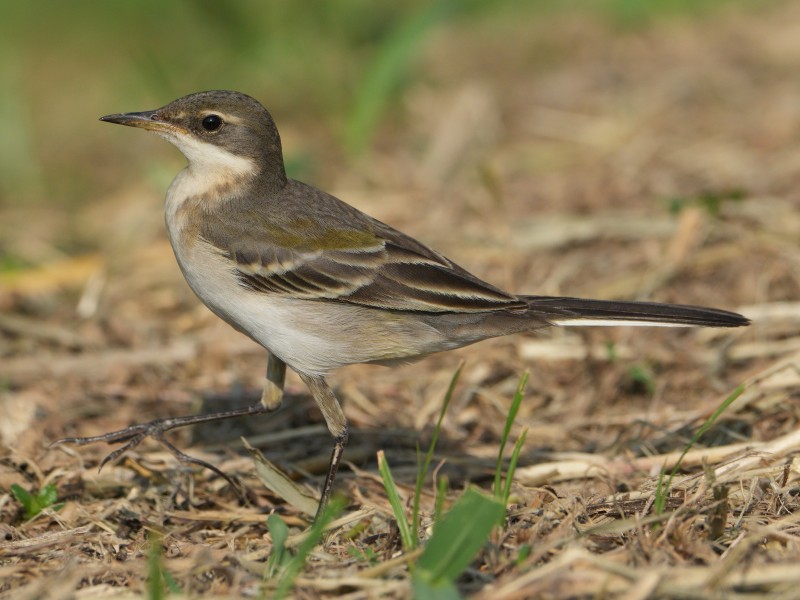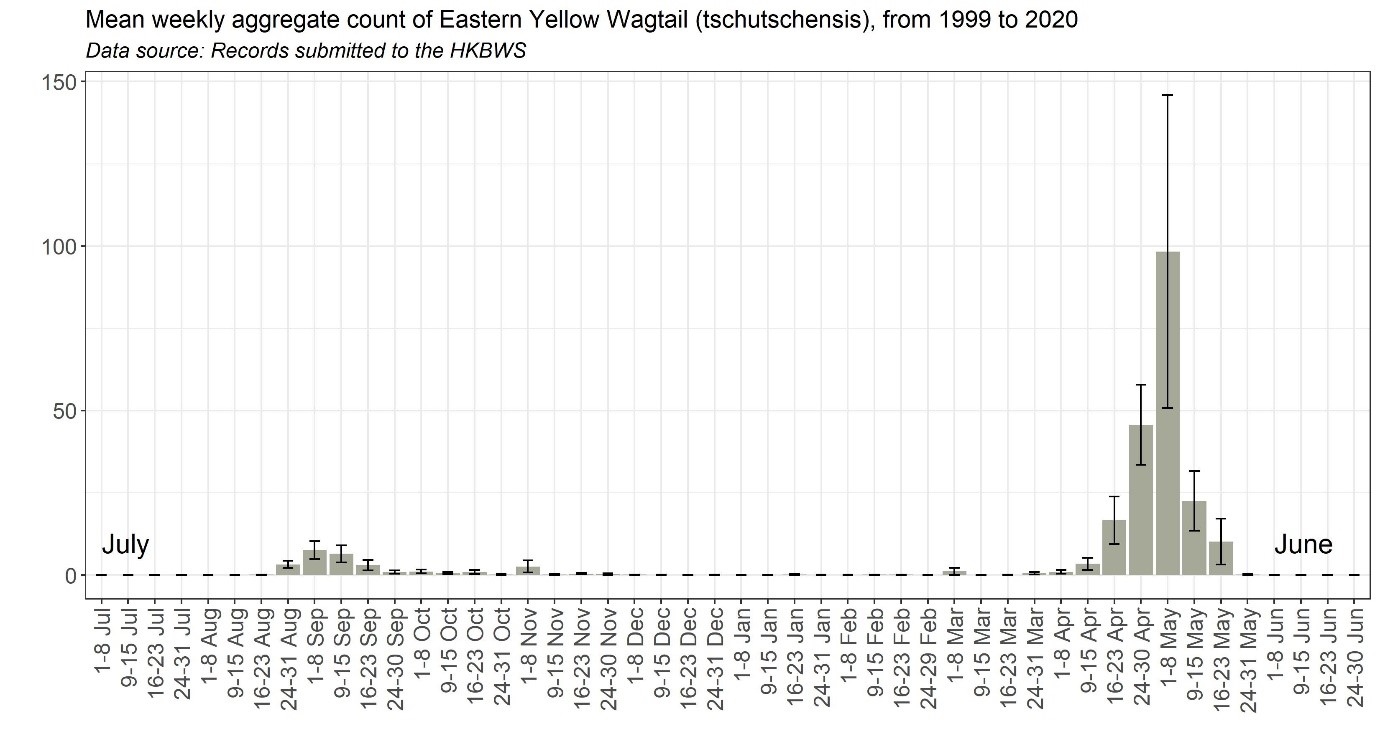Eastern Yellow Wagtail Motacilla tschutschensis tschutschensis 東黃鶺鴒
Category I. M. t. tschutschensis is a passage migrant, common in spring and uncommon in autumn, and a rare winter visitor. Frequents freshwater marsh and fish pond areas.
IDENTIFICATION

Apr. 2021, Roman Lo. Breeding plumage.
17 cm. In breeding plumage has a grey head with a long, narrow (relative to taivana) often crescentic white supercilium that does not generally reach the bill and is tapered at the rear. Females in breeding plumage resemble dull males, while first-winter birds resemble adult females. (Alström and Mild 2003).

Oct. 2024, Paul Leader. First-winter.
On young birds the width of the supercilium usually distinguishes from taivana.
VOCALISATIONS
The typical flight call of the three commonly-occurring Eastern Yellow Wagtail taxa in HK is a rather harsh ‘tzeep’ that falls in pitch terminally and is similar to that of Citrine Wagtail.
DISTRIBUTION & HABITAT PREFERENCE
All taxa of Yellow Wagtails frequent low-lying marshy areas, wet agricultural areas, fish ponds, reclaimed areas and other open country habitats with short vegetation, mainly in the northwest New Territories.
OCCURRENCE
Figure 1 indicates tschutschensis is most numerous in spring, with main passage from the third week of April to the third week of May, peaking in the first week of May (notably later than taivana). The first spring migrants generally appear in the final week of March or first week of April, while the latest occurred on 27 May 2007.
In autumn the earliest record is 18 August 2015, and in most years the first birds are noted in the final week of that month. The main passage period ends in the third week of September, with very small numbers sometimes continuing to pass into the first half of November. Rare in winter, there were only two reports in December, three in January and six in February in the period 1999-2020. Partly this may reflect difficulties in identifying birds, especially first-winters, at this time, but it is considered a true reflection of scarcity.
Three-figure counts in spring are not unusual, but the highest numbers are often associated with bad weather. An extremely large influx of at least 3,775 birds occurred on 24 April 1997 as follows: 2,500 at Lin Barn Tsuen, 500 at Mai Po, 625 flying northeast at Chek Lap Kok and 150 at Shuen Wan. In addition, due to the close approach of a tropical storm, 1,160 birds were reported at three sites from 30 April to 2 May 1999, in addition to 3,018 birds flying north over Cheung Chau from 1630h to 1815h on 1 May 1999 that were presumed to be this taxon.
Autumn passage is far less pronounced than in spring, with up to 45 reported during September and October. There was, however, an exceptional count of at least 200 on the south side of HK Island on 6 September 1964 after the passage of a typhoon.
Herklots (1934, 1953) considered tschutschensis to be a very rare migrant, while Dove and Goodhart (1955) mentioned only records of tschutschensis and macronyx (the latter of which they regarded as the rarest). Macfarlane and Macdonald (1966) stated tschutschensis was uncommon in spring but more frequent in autumn, the reverse of the perception now.
BEHAVIOUR, FORAGING & DIET
Walks and runs pumping tail, but less intensely than White Wagtail. Flight is slightly weaker than that of White Wagtail, and more resembles that of pipits. Generally showy and vocal, if not very approachable. More likely to occur in flocks than White Wagtail, and more so than other taxa of Eastern Yellow Wagtail on migration. Forages on invertebrates on the surface of mud and plants, but no details.
RANGE & SYSTEMATICS
Eastern Yellow Wagtail M. tschutschensis comprises four subspecies: plexa, tschutschensis, macronyx and taivana. M. t. tschutschensis breeds in east Siberia south to Transbaikalia and northern Mongolia (north of macronyx), Amurland, Sakhalin and north Japan; it winters from south China, including Hainan and Taiwan, through southeast Asia as far as the Greater Sundas (Badyaev et al. 2020), although the pattern of occurrence in HK indicates it is scarce in south China in winter.
CONSERVATION STATUS
IUCN (Motacilla tschutschensis): Least Concern. Population trend decreasing.
Figure 1.

Alström, P., K. Mild and B. Zetterström (2003). Pipits and Wagtails of Europe, Asia and North America. Christopher Helm, London.
Badyaev, A. V., B. Kessel, D. D. Gibson, J. del Hoyo, and N. Collar (2020). Eastern Yellow Wagtail (Motacilla tschutschensis), version 1.0. In Birds of the World (S. M. Billerman, Editor). Cornell Lab of Ornithology, Ithaca, NY, USA. https://doi.org/10.2173/bow.eaywag.01
Dove, R. S. and H. J. Goodhart (1955). Field observations from the Colony of Hong Kong. Ibis 97: 311-340.
Herklots, G. A. C. (1934). The birds of Hong Kong. Part XVI. Family Motacillidae (Pipits and wagtails). Hong Kong Naturalist 5: 163-169.
Herklots, G. A. C. (1953). Hong Kong Birds. South China Morning Post, Hong Kong.
Macfarlane, A. M. and A. D. Macdonald, revised by Caunter, J. R. L. and A. M. Macfarlane (1966). An Annotated Check-list of the Birds of Hong Kong. Hong Kong Bird Watching Society, Hong Kong.

